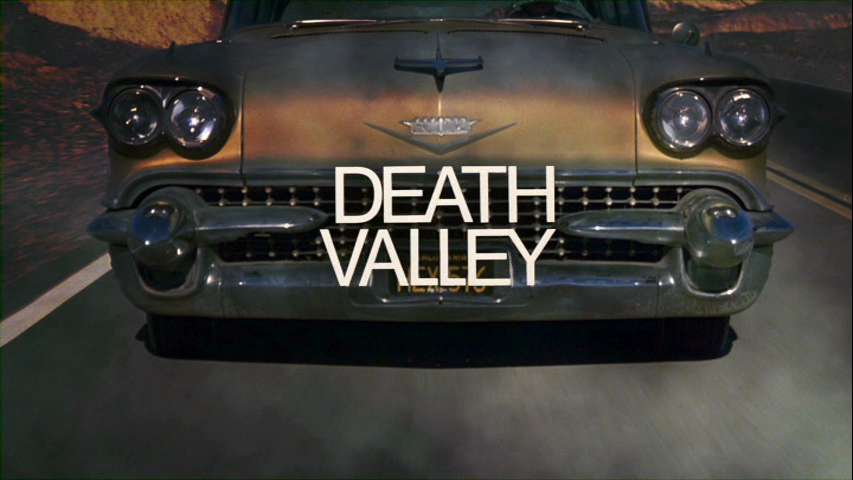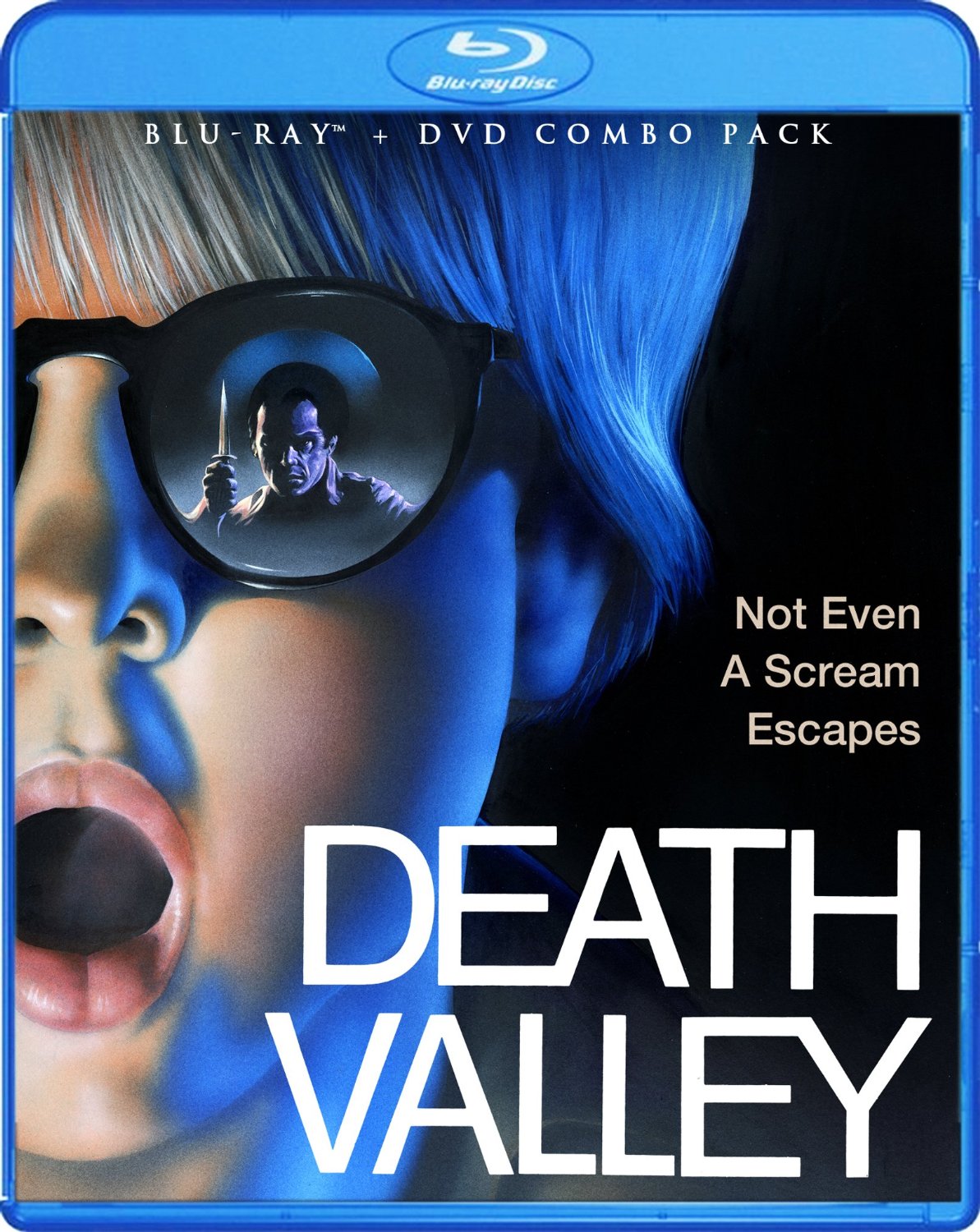
 BUY FROM AMAZON: CLICK HERE!
BUY FROM AMAZON: CLICK HERE!
MSRP $26.99
RATED R
STUDIO Shout! Factory
RUNNING TIME 87 Minutes
SPECIAL FEATURES
• Audio Commentary with director Dick Richards
• Theatrical Trailer
• TV Spot
The Pitch
Ralphie had some messed up adventures before A Christmas Story.
The Humans
Peter Billingsly, Stephen McHattie, Paul Le Mat, Catherine Hicks, A. Wilfred Brimley
The Nutshell
A divorcee, her son, and her boyfriend are on a vacation in the beautiful but deadly Death Valley. What starts out as an ordinary, leisurely trip turns into a nightmare when they happen upon a murder and find themselves pursued by a maniac.
The Lowdown
The slasher movie craze of the late 70s and pretty much the entirety of the 80s is a thing of legend now. It was either a renaissance period or the trend that irreparably injured the horror genre for decades to come (depending on who you ask). Looking back, it’s easy to see that there was a lot of crap and a lot of the mainstream slashers of the era (Friday the 13th, any of the Nightmare on Elm Streets or Halloweens past the first one, ditto with the Child’s Play series) were only good with an asterisk at the end reading “for a vapid silly exploitation movie.”
Still, there are movies that aspired to be more, and the DVD boom has given little gems like The Burning, Slumber Party Massacre, Intruder, and Christmas Evil the praise they deserved all along. For some of these movies, it was a dark sense of humor or a compelling killer, or maybe a subtle send-up of the genre and its tropes that made them memorable. But for the slower less-exciting entries, their hook was having well-written and sympathetic characters that served as a purpose deeper than “meat for the grinder.” Death Valley is one such movie.

“You should say ‘you’ll shoot your eye out.’ That never gets old.”
The film opens on Billy (Peter Billingsly of A Christmas Story) and his father enjoying a day out in New York City. It’s a brief montage that could easily belong in a movie like Kramer vs. Kramer but it firmly establishes the love between father and son in a short amount of time. Finally the day ends and they arrive at Billy’s mother’s building. Billy invites his father up to play and he politely declines, giving a very heartfelt speech about how they both love Billy but can’t stand each other. Both father and son tear up and you can see the love and the heartbreak on both their faces as they say goodbye. This scene does two things: it gives a real, honest, and simple statement on the nature and emotions of a divorced couple with a child and it makes the audience want nothing bad to ever happen to this kid so long as he shall live.
That moment with Billy’s dad (who isn’t seen again for the entire movie) puts the audience in Billy’s mindset early on. It makes his mother’s (Cathrine Hicks) vacation to Arizona (really a dry run on moving there) and canoodling with her boyfriend Mike (Paul Le Mat) feel mean-spirited and selfish, and Mike’s patronizing attempts to win Billy over feel pathetic and manipulative. After an uncomfortable first meeting, the three drive off into the desert where Billy spies an ominous golden car with a big scary grill as instantly iconic as the truck from Duel or the car from The Car.
We’re then whisked away to a Winnebago containing a trio of the most 70s looking people ever. There’s a bit of gratuitous “fuck you, that’s why” nudity, and then a man whose face can’t be seen paints some fake blood on their necks with a big knife. This scene is awful in just about every way, and seems to have been transplanted from an entirely different movie. My only guess is that it was a studio-mandated thing so it would be bumped up to an R rating and give the mouth-breathers something to howl at. In any case, it’s tonally inappropriate to the rest of the movie and pretty half-assed on its own.
After this, our heroic trio pulls off to at an abandoned gold mine, because of reasons, and Mike decides that it would be perfectly safe for a small child to wander around the desert at mid-day in blue jeans and a long-sleeved shirt by himself. When Billy finds the dreaded Winnebago he cautiously wanders inside where the killer has thankfully cleaned up all the exploitation movie he splattered everywhere in the previous scene. Billy finds a kick-ass frog necklace and promptly pockets it before Mike shows up and tells Billy to stay out of strange recreational vehicles.
They encounter the RV again on their ride to a ghost town, only now it’s in flames in a canyon. Billy confesses taking the necklace and seeing the creepy gold car at the scene of the crime to the Sheriff (Wilford Brimley). The sheriff then takes this crucial piece of evidence with him to the killer’s home, by himself and without telling anyone where he is going, tells him who found the evidence and WHERE HE IS STAYING (!!!) then decides to take the killer’s word that his equally murderous brother isn’t home after checking behind one door. My going theory is that the sheriff was just extremely drunk at the time. Now the killers are out to kill Billy so they won’t get caught, this is facilitated by Billy’s mother and Mike doing an awful job of keeping an eye on him.

This baby has seen some shit in his day.
Billy’s mother is vilified pretty early on in the the movies, but she becomes more sympathetic about twenty minutes in when Billy’s opinion of her softens. Still she seems to care more about spending some time with her new beau than she does with making sure her child is adjusting well to the divorce or even not in mortal peril. Even when her pettiness disappears she comes across as selfish and suffering a dearth of maternal instinct. Catherine Hicks plays the role with charm and exasperation and it’s not hard to buy her as a young mother of a boy like Billy.
Mike is just a shit-heel. He’s obviously uncomfortable with the situation and just seems to want to make peace with Billy, unfortunately he just desperately tries to form a bond that would take years to establish in a long weekend. He also has no idea how to deal with or take care of children; in one scene he just walks off and leaves Billy alone at the crowded motel swimming pool. This works really well for the character and makes him feel a lot more human than making him stunningly perfect or just a complete asshole would have. It’s Mike’s thinking that saves Billy’s life in the end and I think he redeems himself by the time the credits roll. Paul Le Mat is a little bit wooden at times but his performance comes across pretty well.
Steven McHattie’s sleazy killer is quietly menacing and cool in a performance reminiscent of Robert Mitchum or Rutger Hauer. He doesn’t quite pull it off when his character becomes a gibbering wild-eyed madman at the film’s climax, but I would still file the character strongly in the pros rather than cons section.
Billy is a rarity in horror movies: a child who acts like a child. Early scenes establish that he’s well-learned (most likely due to his college professor father) but his maturity level is on-par with a child his age. He doesn’t have that smirky Macauly Culkin sense of self-awareness that most movie kids have. The way he cases the RV before snooping in it, the way he isn’t even aware he’s in danger until he’s at the killer’s mercy, the way he earnestly and tearfully apologizes to the sheriff when he confesses to taking the necklace all feel like the way a child would behave. When he makes stupid mistakes it doesn’t feel like bad writing because he’s six or seven years old. The movie puts you inside Billy’s head and he’s a magnetic protagonist simply because it’s so easy to empathize with and worry about him. A lot of credit goes to the director but I really cannot oversell Peter Billingsly’s performance enough. Ralphie from A Christmas Story may be his most famous role but I daresay that this one is his best.

Not just A. Wilford Brimley, THE Wilford Brimley
Throughout the movie I kept getting a strong Alfred Hitchcock vibe; this really isn’t surprising since Death Valley has more in common with Cape Fear or Alice, Sweet Alice than it does with Sleepaway Camp or Dr. Giggles. It even evokes desert-road thrillers like The Hitcher, Duel, and Highwaymen. The thing that really makes this surprising is that the movie is actually pretty dumb. I’ve hit a few points in my above synopsis but there’s scads more peppered throughout the movie. Death Valley is basically a taut, smart, and tense Bruce Banner of a thriller that occasionally gets excited and changes into a giant mentally retarded Hulk of a slasher movie.
This brings up a “chicken or egg” conundrum. Did the studio push the stupidity on the movie to make it fit more into the slasher movie template that all the promotional material for this movie wants us to believe or was the promotional material done to sell a flawed smart movie to a simpler and more accepting audience? In any case, the stupidity isn’t terribly intrusive and while a good share of the credit for that goes to the cast, the crew really deserves a shoutout here.
Director of photography Stephen H. Burum makes the movie beautifully scenic. Shooting in the actual Death Valley helped this, but having seen my share of awful looking movies that were filmed in Namibia it’s obviously a bit harder than it looks. Burum would later go on to shoot several Brian de Palma movies (most notably The Untouchables) and that talent shines just as brightly here as there. You can pause just about any scene in Death Valley and find something interesting in the background to look at, and that includes interiors as well as exteriors. There’s a depth and character to every set, and things just have a more lived-in quality than many other movies (especially of this era) do.
Death Valley has its share of flaws. It’s a bit schizophrenic and I can see how that kept it from having a lasting appeal with mainstream audiences. Death Valley is a testament to how good actors, a director, and crew can elevate bad writing into a good experience.
The Package
It’s a pretty bare bones release from Scream Factory. There’s an audio commentary with Dick Richards but the man clearly can’t remember a whole lot about the movie and most of the run time is him talking about the film industry and various actors with the other guy on the commentary track. There is a theatrical trailer and a TV spot.
The DVD is presented in 1.78:1 Anamorphic Widescreen with Dolby Digital Mono audio and the Blu-Ray is presented in 1.78:1 1080p High-Definition Widescreen with DTS HD Master Audio. Both discs have English subtitles.
Rating: 




Out of a Possible 5 Stars